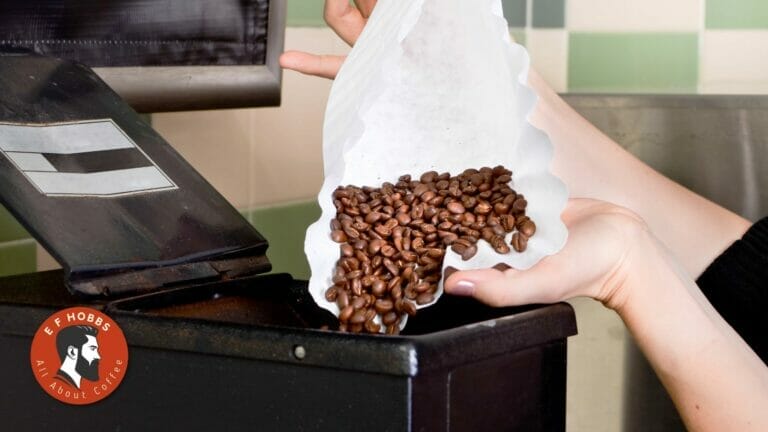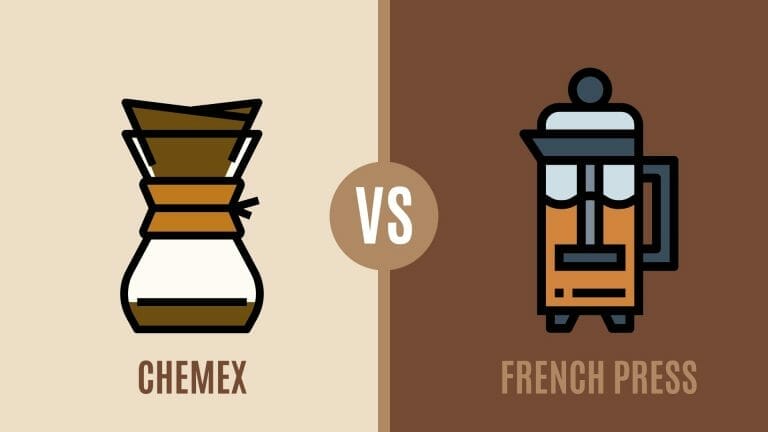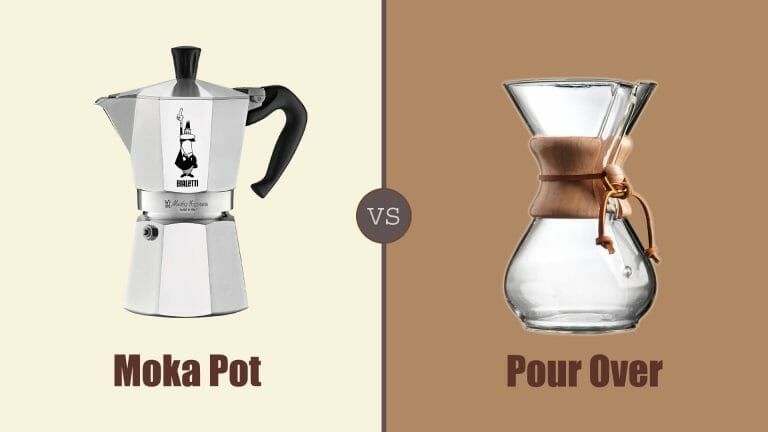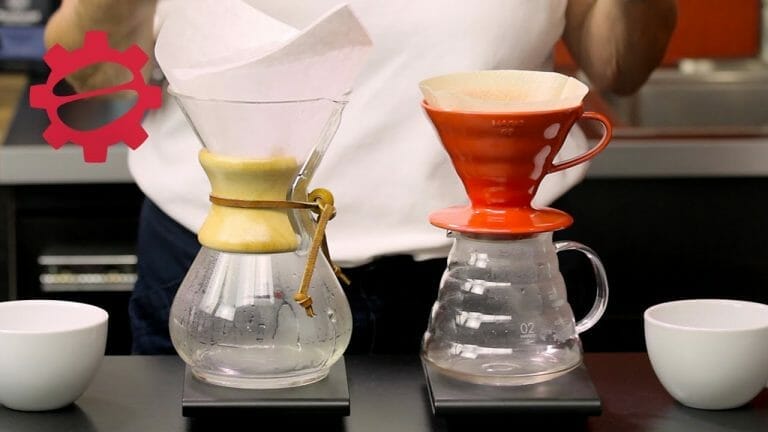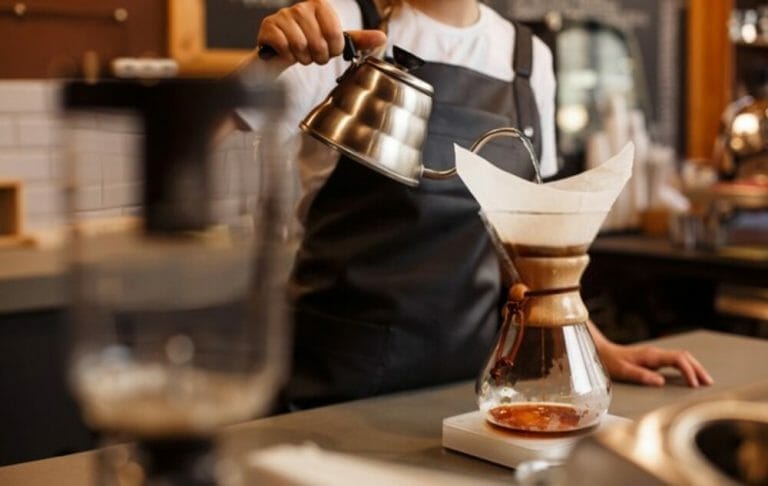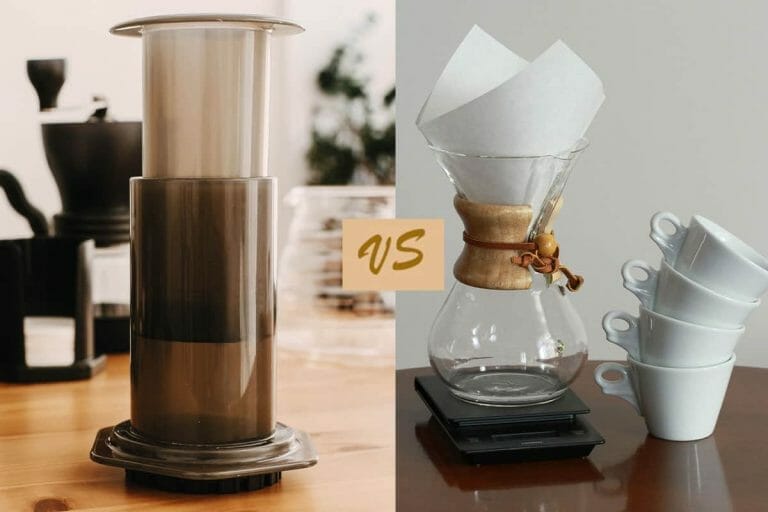Pour-Over FAQs – All Questions Answered
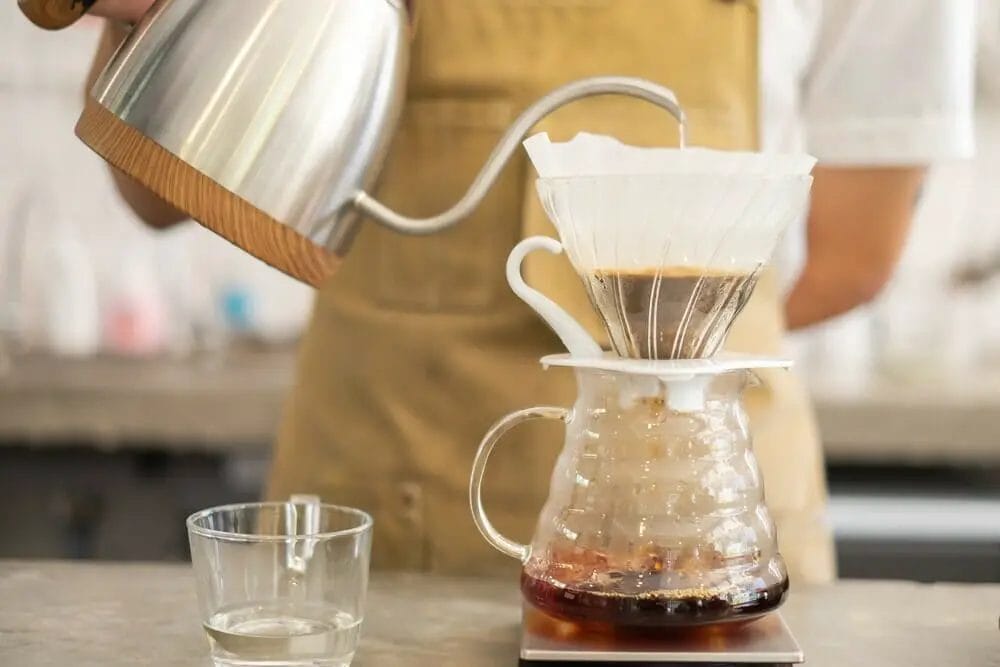
[amazon Box=”B000I1WP7W” ]
Do you need a scale for pour-over coffee?
Scales bring consistency to pour-over coffee that makes some delicious coffee. This consistency is essential to brew the coffee that involves lots of experimentation with ratios and variables.
So the answer is yes. You will need a scale for a pour-over coffee, but it isn’t indispensable. You can make pour-over coffee without a scale as well.
How to order a pour-over at Starbucks?
You’ll find yourself ordering coffee from Starbucks more often if you use the pour-over method.
The pour-over option may not be on the menu, but you can always ask for it. The custom brewed pour-over is known for its clarity and smooth taste.
If the barista doesn’t know about pour-over coffee, ask for a black coffee or latte. Then, the barista will understand that you want a smooth drink that will not overwhelm your palate with solid flavours.
How to make a cold brew with pour-over?

To make cold brew using pour-over, you will need:
Ingredients
- 14 ounces hot water
- 1/4 cup whole bean coffee
- 2 cups ice
Equipment
- Scale
- pour over cone
- Filters
- kettle
- coffee grinder
Instructions:
- Step 1: Boil the water in a kettle. Remove from heat, and let it cool.
- Step 2: Prepare the pour-over cone by putting the filter in the cone and rinse with clean water.
- Step 3: Grind the coffee beans in a grinder and place them in the pour-over cone. Add the ice to the filter.
- Step 4: Pour the hot water through the pour-over cone and bloom it for about a minute. Pour the remaining water in circles.
- Step 5: Strain the coffee onto fresh ice in the cup.
- Step 6: Enjoy your pour-over!
Do you need a special kettle for pour-over coffee?
The gooseneck kettle is the most recommended special kettle because it enhances control and precision in pouring.
A gooseneck kettle has a long, thin, and flexible spout that allows you to control water flow with speed and direction. The pour-over method requires a gentle flow of water as it hits the grounds.
A gooseneck will give you control over the water’s direction and speed. The more flexible the spout, the better it is.
Drip-style kettles that are easy to find in local stores won't work well for pour-over because they don't allow you to control the flow and direction of the water.
Gooseneck kettles are available at specialty retailers. A regular kettle with a spout that will enable control would work just as well if you cannot get one.
Does pour-over coffee have more caffeine?
Yes, thanks to the longer time this method takes. It contains twice as much caffeine as an espresso shot.
The average cup of brewed coffee has about 145 mg of caffeine. That is more than the espresso shot.
A cup of drip coffee has about 130 mg of caffeine, and a single espresso shot has just 80 mg of caffeine.
How to use a Melitta pour-over?
To use a Melitta pour-over, you will need:
Ingredients
- Coffee beans
- Water
Equipment
- Melitta or other pour over cone
- Gooseneck Kettle
- Scale
- Coffee grinder
Instructions:
- Step 1: Grind the coffee beans to a medium to medium-fine grind size in a grinder.
- Step 2: Boil the water between 195F to 205F in a kettle.
- Step 3: Put the filter over the cone and rinse. Set the cone on a cup or a carafe for serving.
- Step 4: Pour the coffee grounds into the filter. Let the coffee bloom for about 30 seconds.
- Step 5: Continue pouring water over the grounds until you reach your desired strength. Don’t pour the water too fast.
- Step 6: Discard the filter and remove the Melitta from the cup.
- Step 7: Enjoy your pour-over coffee!
What does a pour-over mean at Starbucks?
Starbucks will serve pour-over coffee. They sell the tools and allow you to make your own café au lait. The pour-over is a specialty coffee known for its clarity and smooth taste, which doesn’t overwhelm the palate.
Starbucks baristas will pour water over freshly ground coffee beans to brew each cup of coffee.
The brewing process is part of the barista craft for Starbucks. Coffee lovers can choose to add coconut milk or regular milk to their beverages.
In addition, the barista can customize the cup by adding or removing milk, sugar, and other ingredients such as lemon or cinnamon. It's a very memorable coffee experience.
Why is my pour-over coffee bitter?
There may be several reasons why your pour-over coffee is bitter.
Overcooking: Steeping the coffee is only part of the brewing process. The other part is the filtering. Overcooking can cause bitterness.
Too hot water: Use a thermometer to measure the temperature of the water. You need to use 195 to 205 degrees Fahrenheit. 212F is too hot and causes bitterness.
Over-extraction: This makes the coffee taste bitter, similar to burned food. It is also called “channelling.” Some grounds or cones will channel the water into a puddle at the bottom of the cup. The high concentration of tannins and caffeine in an over-extracted brew might be overwhelming.
Fine Grind: The grind size of the coffee can affect the taste. It affects how fast water flows through the grounds, which determines extraction and bitterness. If your coffee is ground too finely, water flow is too fast, and the tannins get channelled into the puddle. As a result, the coffee’s taste can become bitter.
Can you pour hot coffee over ice?
You can pour hot coffee over ice or frozen cubes. It’s also called a freeze-drip.
It is not a way to make cold brew coffee, which requires water below room temperature.
Hot pour-over brewing allows you to preserve the fresh taste of the coffee and ice together in one cup, with the bright and fruity flavours of the ice melting into your hot cup of coffee.
The heat from the brewed coffee melts the ice at first. When the ice melts, the coffee and its oils are about 70 degrees cooler. As a result, the coffee stays in its taste and makes you feel refreshed.
Can you use pre-ground coffee for pour-over?
Yes, you can use pre-ground coffee for pour-over. But if you want more flavour, you should use freshly ground coffee right before you are brewing.
The best grind for pour-over is medium-fine, about a brew size between drip and French press.
Using pre-ground coffee for pour-over will result in less flavorful coffee. It is because fresh coffee grounds have their natural oils. As a result, they give off flavours when you pour hot water.
Does Starbucks do pour-over?
Starbucks is known to serve the best coffee globally, and yes, they do pour-over using a unique pour-over cone. It is a cup with a filter on its bottom.
The barista will pour hot water into the cup and let it steep for a few minutes. Then, they will slowly pour hot water into the cup again to brew the coffee.
The barista will make sure that each cup of coffee is brewed correctly and tastes excellent. In addition, Starbucks offers pour-over coffee exclusively at their “Starbucks Reserve” locations in the US and Canada.
How to make a solid pour-over coffee?
For a more robust cup of pour-over coffee, you can increase the number of coffee beans used.
You can also increase the brewing time to get more flavour. The best brewing time is between 2:30 and 4 minutes.
- Double pour over the coffee: The most common pour is a single pour. The time it takes the water to saturate the coffee beans and flow through the filter gives the coffee its strength. If you double this time, your coffee will be more robust because there is more time for the essential oils and tannins to get into the water. You can repour the same coffee for a second time for that intense cup of coffee.
- Coffee and water ratio: You can increase the coffee used for a more potent brew. Use about 18 grams of coffee or about two tablespoons for every 250 ml of water.
- Check your extracting process: Are the grounds fully saturated with water? Check your progress regularly during the first 30 seconds of brewing. If you see that the coffee is starting to channel, it’s time to make a new filter. Make sure you use the proper methods to extract coffee.
Is Chemex the best pour-over?
The Chemex is a pour-over coffee brewing method that avoids hot water spilling on the grounds and produces an excellent coffee cup in only two minutes.
It makes the optimum ratio of water to coffee that has been roasted just enough for its taste, but not so much that it becomes bitter.
Chemex is known to produce a very clean cup. It gets rid of the muddy taste and the sour coffee tongue aftertaste.
The V60 is the best-known of the pour-over coffee brewers. It is a ceramic cone filter that is used for brewing coffee. It has a very modern design that ensures smooth and great-tasting coffee every time.
In addition, the V60 brewer features even water distribution, which makes it easy to achieve an even extraction.
Its purpose is to deliver a balanced yet flavorful cup of coffee. It uses a paper cone filter with 155-micron pores, which allows you to control how much oil goes into your cup of coffee.
If you want the best tasting cup of coffee, go for Chemex. On the other hand, if you’re in a hurry and need a quick cup of brew, choose V60.
Can you use espresso beans for pour-over?
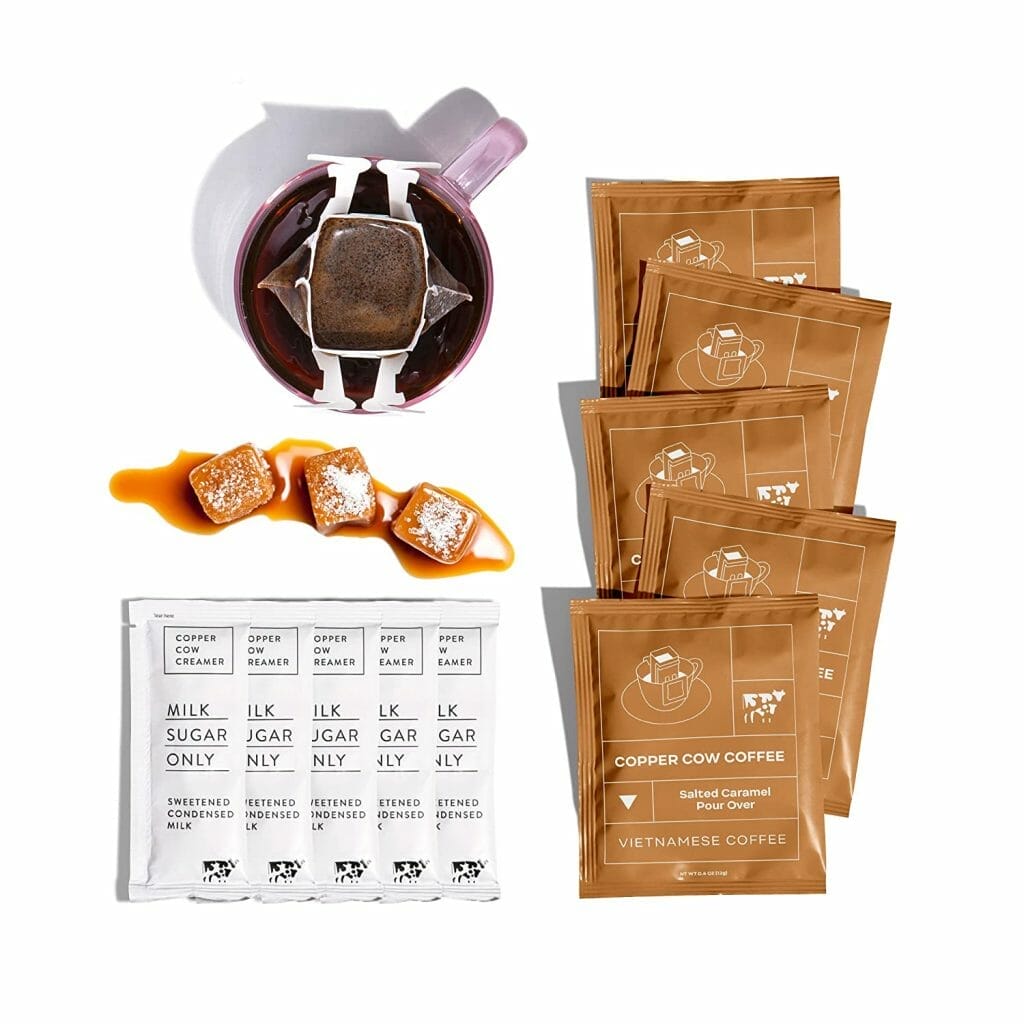
You can use espresso beans for pour-over. They are single-serve grinds that require no additional preparation. However, you need to buy a grinding machine so you can grind the beans yourself.
If you want the best tasting cup of coffee, use regular coffee beans that have been ground just before brewing. Espresso beans are highly roasted, and an extra amount is needed to get their full flavour.
It has a more pungent taste because of its instant extraction process, but not as strong as coffee shop espresso.
You should store the coffee beans inside an airtight container. When you keep the beans at room temperature, they will be dry and remain fresh for about one month. However, if you store your beans in the freezer, they can last up to six months.
How long should a pour-over take?
The best brew time for a pour-over is 2:30 to 4 minutes. It is because it takes about 1 minute for the water to infuse with the coffee.
The water should then be slowly poured through and filtered for another 2:30 - 3 minutes.
Longer brewing times may result in under-extracted coffee, which has a sour taste. Under-extracted coffee will have a green flavour and bitterness.
It may not suit everyone's taste, but it is better than an over-extracted coffee with a bitter and burnt taste.
So we recommend that you make your coffee without wasting the rest of the water or grounds in your cup.
How to make coffee with Bodum pour-over?
To make coffee with a Bodum pour-over, you need to use the filter cone. Also, rinse the Bodum with water before and after using.
To make great coffee with Bodum pour-over, follow these simple steps:
- Step 1: Put your pot on a flat, heatproof, un-slippery surface
- Step 2: To make a better coffee, add ground coffee to the cone. We recommend using one spoonful of ground coffee or one teaspoon in 4 ounces of water.
- Step 3: Pour hot water over coffee grounds in a circular motion until they’re evenly saturated. Then bring the water up to maximum height.
- Step 4: Water should be allowed to flow through the borosilicate glass carafe for four minutes.
- Step 5: Remove the filter, insert the lid, and pour a great cuppa coffee.
How to make pour-over coffee with a metal filter?
A metal filter is not typical to make pour-over coffee, as most people use paper filters. However, you can find this method in Asian countries, making it easier to get the correct extraction of coffee.
To make a good pour-over with a metal filter, follow these steps:
- Step 1: Add coffee beans to the filter and then rinse the grounds out by pouring hot water into the filter. This step is to ensure that there is no residual coffee on the grounds.
- Step 2: Let the grounds sit for 30 seconds until they have a chance to bloom. It will release the essential oils that are needed for brewing. You can do this by pouring boiling water into the filter and then steep it for 30 seconds.
- Step 3: Pour water over the grounds in a circular motion using a kettle or pitcher of hot water. Try to keep the temperature of the water as consistent as possible.
- Step 4: Allow the coffee to flow through the filter and into a glass vessel or empty cup. Avoid pouring over the grounds again to get a cleaner taste.
Can you make a latte with pour-over coffee?
If you want to make a latte with pour-over coffee, you need a milk frother that will help create the perfect layer of foam.
You can use a stovetop espresso maker or an Aerolatte Milk Frother for this purpose. It will help you give your cup of coffee its creamy texture when poured over your drink or into your cup.
Follow your usual pour-over method but also add froth and sugar to your coffee. Make sure to use the correct ratio of water and milk. Too much water will dilute the taste of your latte, while too little water will result in an unbalanced cup.
Can you make espresso in a pour-over?
No, you can’t make espresso in a pour-over. Espresso is made with an espresso maker that requires pressurized water to extract the coffee.
In addition, the espresso maker will require that you use a specific coffee bean. It is because they are ground differently and require low water pressure to extract their flavours.
Can you make pour-over coffee with cold water?
Pour-over coffee tastes best when brewed with hot water. You can use cold water, but it will result in a bland, dull taste in your cup of coffee.
Using boiling water or hotter will increase the temperature of the brew. The ideal temperature for brewing good quality coffee is between 82°C and 95°C, according to specialty coffee standards.
Does pour-over coffee raise cholesterol?
No, pour-over coffee is unlikely to raise your cholesterol level. However, research has estimated that drinking coffee can raise cholesterol levels.
Coffee contains around 96 calories per cup, and if you drink more than three cups a day, it will increase your calorie intake.
In addition, it can raise your cholesterol level if you do not exercise or have a healthy diet with low cholesterol.
How to clean Bodum pour over?
To sanitize your Bodum pour-over:
- Use hot water and lemons.
- Mix a few drops of lemon juice with natural or green tea.
- Fill the filter cone with this mixture and then rinse it out. You can also make use of boiling water to sanitize your pour-over coffee maker.
How to clean KitchenAid pour-over coffee maker?

Here are some tips for maintaining a clean KitchenAid pour-over coffee maker:
- Baking soda: Use baking soda to clean the inside of the percolator. Clean with a mixture of warm water and baking soda. Turn on the machine so that the mixture is forced through the mesh. Rinse with clean water and dry.
- Vinegar: Mix white vinegar and water in equal parts. Brew and repeat the process until it is cleaned. You can even use apple cider vinegar if you don’t have white vinegar available at home.
- Alka Seltzer tablets: Use alka seltzer tablets to clean the machine. Turn on the machine and pour in half a tablet. Run for 2 minutes and then run water through the machine. Rinse with clean water and dry.
- Lemon: To clean the inside of your KitchenAid pour-over, mix vinegar or lemon juice with boiling water and sprinkle on top of the percolator twice during its run cycle. Run the process twice and then rinse well with warm water to remove lemon residue.
How to clean a metal pour-over coffee filter?
Cleaning the filter is essential in maintaining a healthy and clean pour-over coffee maker. Here are some tips for cleaning a metal pour-over:
- Use baking soda: Make a baking soda paste and water to remove stains from the filter mesh. Allow the paste to dry overnight. Scrub the dried paste off with salt and clean water. Rinse and dry the filter wholly before using it again.
- Use White vinegar: Vinegar is a natural cleaner for metal pour-over coffee filters. Mix vinegar and warm water until you form a paste. Rub the paste into the filter and allow it to dry overnight. Scrub with salt and clean water to remove the vinegar residue. Rinse thoroughly before using again.
- Use citric acid: Citric acid is an effective natural cleaner for metal pour-over coffee filters that can remove stains from powdered grounds, especially burnt or oily stains of espresso cups that are not soluble.
- Gas stove heat: Place the filter on a gas stove burner at medium heat. The burner will burn away all stains and leave behind a smooth finish on the filter mesh. You can also use an oven set to high heat for 2-3 minutes to remove stains.
- Oxiclean and water: Oxiclean cleans and deodorizes the filter mesh. Mix Oxiclean and warm water. Wipe the mixture into the filter mesh, wait for 10 minutes before rinsing clean with plain water.
How to keep pour-over coffee warm?
Let us understand how to keep pour-over coffee warm:
- Use a thermos: Buy a thermos or another type of thermal container from your local store to keep your coffee warm. Coffee will stay hot for 4 hours if stored at 60°C, according to the Brewer’s Guild of America.
- Use opaque mugs: Using opaque mugs will help keep your coffee warm for a longer time. You can place hot or cold coffee in opaque cups and keep them in a perfect space.
- Use towels: Use a thick kitchen towel to keep your coffee warm. Wrap the towel around your coffee cup. If you want to drink a cup of coffee, open the wrapping just enough to sip the coffee and then close it again.
- Heating elements/Hot plate: You can use a hot plate or a heating element to keep your coffee warm. Keep the coffee in an insulated pot set on the hot plate, and it will stay warm for at least 30 minutes.
- Reheat with a microwave: If you want to make a fresh cup of coffee, reheat it for 20 seconds in the microwave. It will increase its temperature by 5-10°C, enough to compete with freshly brewed coffee.
How to make espresso with pour-over?
You can use a pour-over method to make espresso at home. It won’t be quite the same taste as an espresso machine, but it will give you the flavour.
Here are the steps to make espresso with pour-over-
First, you will need:
- A coffee grinder
- A tea kettle
- An electric kettle or burner
- A pour-over brewer
- Dark roast coffee beans
- 3 ounces of water
- Grind beans: Grind dark roast coffee beans using a small to medium setting on your coffee grinder.
- Boil water: Boil water in a kettle or electric kettle.
- Pour coffee and water into pour-over: Place 8.5 grams of dark roast coffee grounds per cup into your pour-over. Pour the water slowly over the grounds, allowing it to drip through without forming bubbles.
- Stir grounds: Stir coffee grounds for the first 1-2 minutes of the pour-over to help them bloom and even extract.
- Wait for coffee to drip: Brew your coffee for about 4 minutes until the pour-over drips through into your cup.
Add little sugar and cream. Enjoy!
How to make pour-over coffee without a kettle?
If you do not have a gooseneck kettle, there is no need to buy one. Instead, it is possible to use a pot and a measuring cup to make pour-over coffee.
This method will not be quite the same as using the gooseneck kettle, but it will give you the flavour and taste of pour-over coffee.
What does pour-over coffee taste like?
Pour-over coffee is the most popular way to brew coffee at home. It is an excellent brewing technique that allows for full flavour extraction and is a simple and easy way to make strong coffee.
The body is light, with more flavour clarity and a mild acidity and aroma. It is also slightly more acidic than drip coffee that allows the coffee flavour to stand out.
It is a versatile brewing method, and you can tailor it as per the drinker’s tastes by adjusting the number of grounds used and the brew time.
Why is my pour-over coffee sour?
If your pour-over coffee is sour, there could be a few reasons.
- Your water might have a high pH level with more alkalinity. It will bring out the bitter flavours and leave your coffee with a sour taste.
- You might have too many coarse grounds in the filter. Use fewer grounds or use finer grounds to get rid of the sour taste.
- The brewing technique might be off. Make sure to stir the coffee grounds at the beginning of the pour-over to spread the extraction evenly.
- Your coffee might be stale. Buy fresh coffee beans and grind them just before you make a cup of pour-over coffee.
How to bloom coffee pour-over?
To bloom coffee is to extract the flavour from the coffee grounds further. To bloom means to make them more active by exposing them to heat or oxygen.
Use medium-fine grinds for the best bloom. Pour a tiny amount of the water at 195F over the coffee in circular motions so that all the coffee grounds are covered and let it sit for 20 seconds.
After that, pour the remaining water into the filter or the coffee maker and let it drop to the final cup.
How to make pour-over coffee while camping?
If you are camping for a short period, you need to carry only the essential items. You will need a pour-over travel mug, coffee grounds, and a kettle to heat the water.
How to make the coffee:
- Boil the water in the kettle.
- While it gets heated, place a medium coffee filter in the travel mug.
- Grind the coffee and put it into the filter.
- Pour hot water over the grounds and let them bloom for 30 seconds to extract maximum flavour.
- Remove the filter and enjoy a pour-over coffee!
How much caffeine is in pour-over coffee?
Pour-over coffee can give you a caffeine boost. However, it is easier to consume than most other brewing methods, so you might want to consider that before you decide to drink your daily dose of caffeine with this method.
A pour-over coffee has on average 80 to 150 mg of caffeine per cup. It depends on the bean. If you have a high-altitude coffee bean, you might have less caffeine.
Dark roasted coffees have more caffeine than light roasted coffees because of the roasting process and how certain compounds are extracted at different temperatures.
How to make pour-over coffee without a scale?
[amazon Box=”B000I1WP7W” ]
If you do not have a scale at home, you can still make pour-over coffee at home. You can use your measuring cups to measure the amount of coffee right.
Six tablespoons equal 30 grams of coffee grounds for a 12 oz or a mug of coffee. You need to boil extra water for soaking and washing the filter. Follow your pour-over guide to make a cup of coffee and use a medium-coarse coffee ground.

